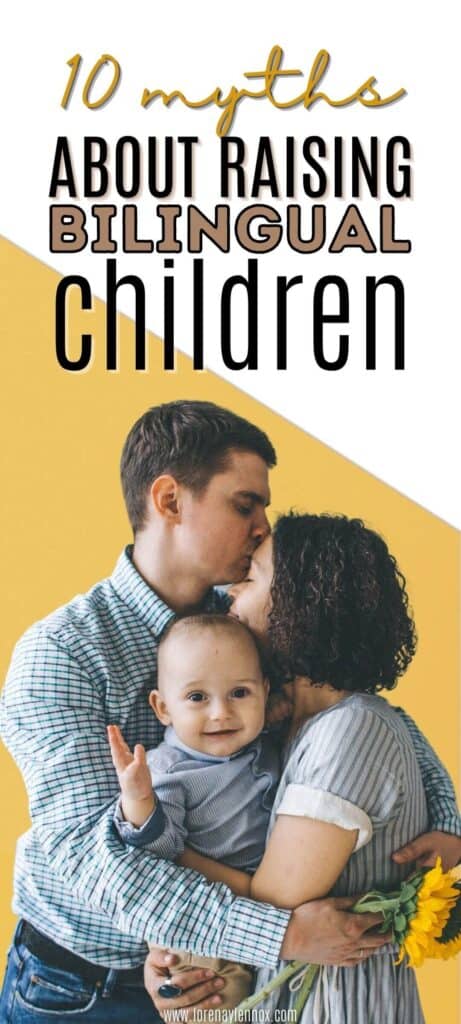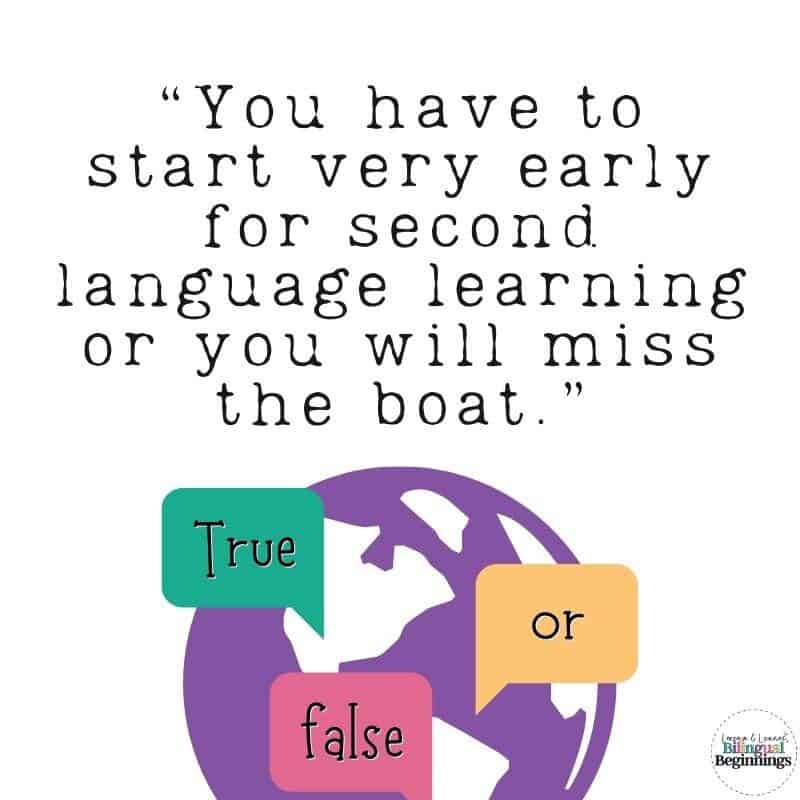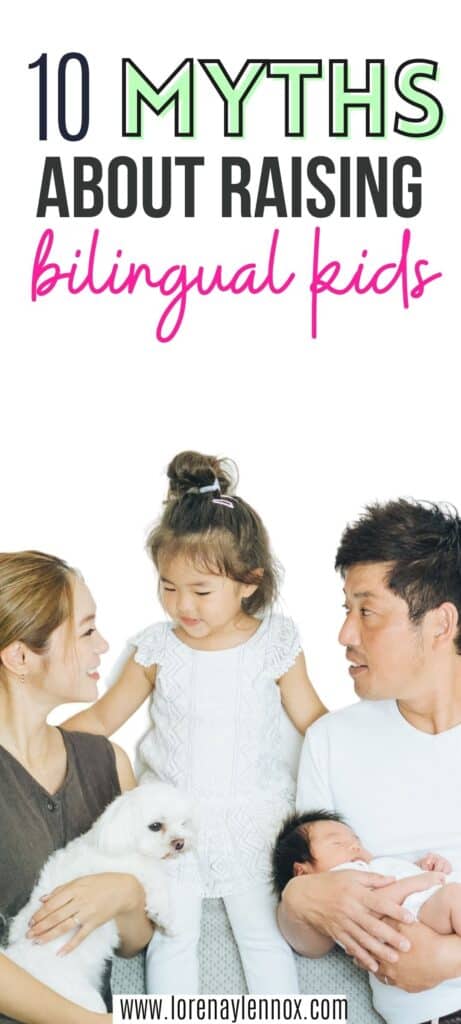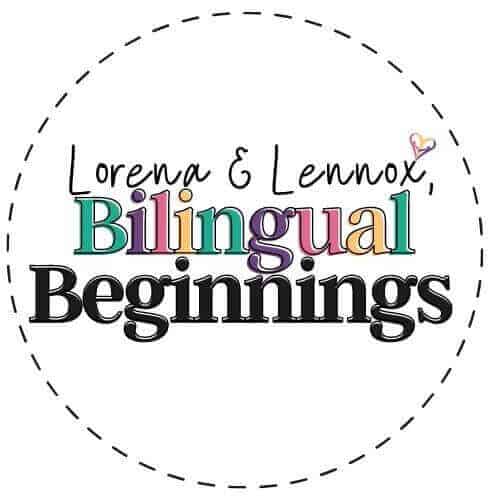In this post, I’ll delve into the intricacies of raising bilingual children by addressing ten common myths surrounding this journey. As a bilingual parent myself, I’ve encountered numerous critics and skeptics questioning the effectiveness and impact of bilingual upbringing.
From concerns about speech delays to fears of confusion, these myths have circulated widely. However, I’m here to share my personal experiences and anecdotes, debunking each myth with real-life examples.
So, let’s dive in and explore the truth behind raising bilingual children. Join me as I shed light on the benefits and misconceptions of bilingualism, empowering parents like you to navigate this rewarding journey with confidence.
And remember to connect with me on Instagram for daily bilingual parenting tips and a wealth of Spanish resources! Together, we’ll unlock the full potential of bilingualism for our children.

A little background first
If you didn’t know already, I have been raising my son, Lennox, in Spanish.
I am not a native Spanish-speaker myself, but I do have many years of Spanish education under my belt.
Speaking Spanish with a child is a whole different ballgame. 15 years of studying Spanish, traveling and living with a Latino did not prepare me to raise a child in Spanish. I am learning a whole new aspect of the language right along with Lennox— new vocabulary, onomatopoeias, gestures, babbles, and more. Its quite fascinating.
Related: 12 Ways to Become Fluent in Spanish Outside of the Classroom
Since I switched my blog to focus more on bilingual parenting, I have realized there are so many studies and approaches when it comes to raising a bilingual child. Hence, I have put more thought into the ways I will bilingually parent Lennox.
Bilingual Parenting Myths
One bilingual study that I am reading is called The Bilingual Edge by Kendall King, Ph.D., and Alison Mackey, Ph.D.. It is such a great read and it has answered a lot of the questions and concerns that I have had in the past two years of raising a bilingual child.
My main concern before reading The Bilingual Edge was Lennox’s speech delay. I blamed it on his exposure to two languages thinking that maybe he was confused with which vocabulary to use and when.
My biggest fear was that my nonnative Spanish wasn’t doing the trick.
I had this lingering doubt that Carlos and I were doing something wrong as parents. That doubt grew when I would hang out with other moms, with children the same age as Lennox who were already speaking in full sentences.
Lennox being a delayed speaker has not been my only concern throughout my bilingual parenting journey. Reading The Bilingual Edge has made it clear that my worries are valid, but I should not be discouraged.
That is why I wanted to dedicate a post to outline King and Mackey’s chapter two Called Myths and Misconceptions about Learning a Second Language: What’s the real deal. In this chapter, the authors debunk 10 myths about second language learning. I want to add examples from my personal experiences to add further clarity.
Myth 1: “Bilingual children will have a speech delay”
Over of the past couple of weeks, Lennox has turned into a loro, a parrot. I am not longer worried about a speech delay because this kid never, stops, talking. The majority of his words are in Spanish and let me tell you how amazing this makes me feel.
Finally, all of my hard work and dedication to only speaking Spanish to him is paying off.
Raising a bilingual child is not easy. It requires planning, time and a solid approach. In our household, we speak to Lennox only in Spanish. This approach is known as the Minority Language at Home (MLAH) approach.
Related: 13 Facts Parents Who Want to Raise a Bilingual Child Need to Know
This approach works for us because I have studied Spanish for quite some time now, and I feel comfortable only speaking in Spanish to Lennox. However, that does not mean that you have to be bilingual for your kid to be bilingual.
There’s another approach called One Parent, One Language (OPOL) which is when one parent speaks in their native tongue, and the other in their native tongue. Experts say that this approach is the most beneficial because the child is constantly being exposed to two different languages.
If your family is monolingual, maybe you could try the Time and Place bilingual parenting approach.
There are so many opportunities and resources available nowadays to raise your child bilingually.
According to King and Mackey, “Bilingualism is increasingly seen as a highly desirable asset.” (20) Maybe you have a nanny who always speaks to your child in a second language. Or, you send your child to a second language school. Even better, you can learn a language alongside your child by reading, going to events, traveling, etc.
Related: Seven Awesome Baby and Toddler Books in Spanish
The whole idea here is that it is possible to raise a bilingual child if your family is not bilingual, or if one parent is not bilingual. It simply requires effort and planning.
As for the second part of the myth, “bilingual parents always raise bilingual children”, I know plenty of families who speak two languages, but do not make it a priority for their children to learn both.
King and Mackey state that this can happen for three reasons.
1. In the United States, there is a monolingual norm.
2. The English language is seen as a high-status, high-prestige language.
3. Children are aware of the status encoded in the language.
In the past, these reasons have caused many immigrant families to give priority to English causing a switch to monolingualism over the generations.
From my personal experience, I know many first-generation Latino immigrants whose children grow up speaking Spanish, go to school, learn English. Their parents do not push for their children to speak Spanish and overtime they lose it. It is so heartbreaking to witness because there is so much beauty in being able to speak two or more languages. This is one of the main reasons for my blog. To advocate bilingualism!
Myth 2: “You have to start very early for second language learning or you will miss the boat”

A young child has an enormous advantage over learning more than one language. They learn at such a quick pace, they are less anxious to make mistakes, and they are innocent of stereotypes and prejudices.
However, this does not mean that an older child or an adult cannot attain bilingualism.
I am proof of that.
I may be slightly obsessed with languages and traveling which was a driving force behind my language learning, but anyone that sets their mind to it can learn a language.
Myth 3: Only native speakers and teachers can teach children second languages.
I am not a native speaker of Spanish, nor am I a teacher.
Even though I do worry at times that Lennox may pick up on some of my grammatical and vocabulary errors, King and Mackey assert that “these sorts of imperfections do not harm or impede children’s language learning.” (23)
As long as a child is exposed and interacting with a second language, they will develop the ability to use it.
With that being said, if you are not a native speaker or a teacher, there are many ways that you can interact with your child in the target language. “The value lies in the interaction” (ibid) Interact with your child through books, music, food, culture and more.
Do not let this myth be your discouraging factor.
Myth 4: “Children who are raised in the same family will have the same language skills as one another”
Even though I am very proud that Lennox understands and speaks Spanish, I know that he will soon go to school and pick up English very quickly.
Once I have a second child, I will not have as much one-on-one time with that child as I do with Lennox now. Also, even though it will be a rule in our home to speak Spanish, there will be times when Lennox might be interacting with his sibling alone, and in English.
I’ve witnessed this with my Latino nieces and nephews. The first-born children have great dominance in Spanish, whereas the younger children are highly influenced by the English spoken by their older siblings and cousins.
Myth 5: “It is important to correct errors as soon as they appear in grammar and vocabulary (to prevent forming bad habits)”
According to the authors, “error correction should be done selectively.” (25) If you overcorrect or correct your child in a way that may embarrass him or her, it can result in a lack of confidence.
This myth was new to me and It makes so much sense.
All children make mistakes in language, whether they are monolingual or know more than one language.
Making mistakes is one of the best ways of learning.
In my personal experience, a lot of my learning took place through my bravery of speaking up, listening, and making mistakes. Sometimes I would get corrected, however, if I was corrected for my every mistake, I might have become disheartened from trying to keep learning.
Myth 6: “Exposing my child to two languages means she will be a late talker.”
As I mentioned in the introduction, this was my biggest concern with Lennox. King and Mackey argue that this is not the case. They say that in general, this is a wide variation in the ages that children speak. While it may be possible that bilingual children take longer to develop their speech (they are taking in two languages, two vocabularies, two grammatical structures) learning two languages itself is not the cause.
Lennox has been an extremely active child from the womb. He was born with a determination to move. He even rolled over at eight weeks.
As an almost-three-year-old, he is extremely athletic. Now, as much as I may have been discouraged that at the beginning of his preschool because some of the other kids were speaking full sentences, I didn’t realize how advanced Lennox was in terms of his motor skills. He can kick a soccer ball better than I can!
In Lennox’s case, he has been way too busy to form words and sentences, but now his speech is unstoppable.
Follow us on Instagram to see how talented he is! Mama’s bias =)
The bottom line, all children develop differently. Some become little poets by two-years-old, and others may be lining up to be the future Messi.
Myth 7: “Mixing languages is a sign of confusion, and languages must stay separate.”
This was another worry of mine. There are some words Lennox says only in English. For example, thank you, I love you, and blue.
At first, I was worried he was confused, but now I realize he has a preference for some words in one language over another. I can easily ask him to go get his carro azul and he will bring it back and say “blue car.”
According to the authors:
“Mixing languages is a normal phase of bilingual language development. It seems to be near-universal among bilingual children and is apparent even at the babbling stage; that is, long before children can say a word in any language.” (27)
It is a short-lived phase.
Myth 8: “Television, DVDs and edutainment, like talking toys, are a great way to pick up languages”
Or so I thought at the beginning of my bilingual parenting.
In actuality, there are no proven benefits of screen-time for infants and toddlers, monolingual or bilingual. The Pediatric Academy recommends no television at all for children under two. (29)
Now, if you read my 7 ways I teach my toddler Spanish post, you know that we do use technology when I have to get things done around the house. That said, when I do use screen-time, it is absolutely in Spanish.
Infants and toddlers need human exposure to a language. They need to be able to pick up the tones of a language, mimic the phonetics, and experience the non-verbal gestures that go hand-in-hand with language.
There are some bilingual interactive toys that are great for language learning. Check out this post here which mentions some great interactive toys that are great for bilingual children.
At home, we try to read a lot in Spanish. We also do a lot of play-based learning with loose parts to evoke conversation and introduce new vocabulary.
Related: How to Read to Your Bilingual Toddler in the Minority Language
Looking for some FREE activities in Spanish for your kids, I have a whole compilation you can check out here!
For older children and adults, technology can provide a fun and positive connection for second-language learning. In my 12 ways that I learned Spanish outside of the classroom post, I mention that one of my favorite ways to learn Spanish is by watching shows in Spanish, while simultaneously reading the subtitles. I learned a lot of new vocabulary, especially slang, this way.
Myth 9: “Bilingual education programs are for non-English speakers”
King and Mackey explain that bilingual education has “radically shifted” in the last decade. In the United States alone there are now more than “350 dual-language schools.” (ibid)
One of my plans is to start up a Spanish immersion play-based preschool. I think starting dual language acquisition early is so beneficial, and I would love to put my education and experience into making this country more bilingual.
Myth 10: “Two languages are the very most a very young child should be exposed to”
The more languages the merrier. According to the authors millions of children grow up learning three or more languages, and there are no negative effects. The only thing they recommend is to make sure the child receives adequate exposure and meaningful interaction in each language.
I studied Italian and Portuguese in undergrad, and I hope one day to pass on these languages to Lennox as well. We shall see.
Well, thank you if you made it to this point. I hope you enjoyed this post. For more information, I highly recommend purchasing The Bilingual Edge. It is so informative. If not, stay tuned because I know I will be referencing it in future posts.
To see Lennox’s Spanish skills up close and personal, follow us on Instagram and/or Facebook. For more bilingual parenting tips and free Spanish activities for kids, subscribe to our blog below! I don’t spam, promise.
Related posts you might enjoy:
- Time and Place Bilingual Parenting Approach
- One Person, One Language Bilingual Parenting Approach
- Minority Language at Home Bilingual Parenting Approach

